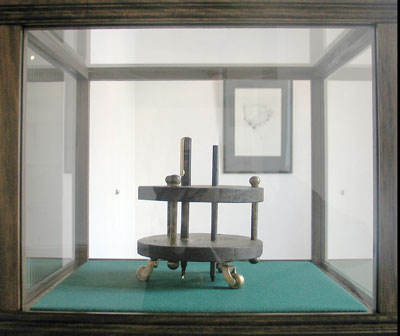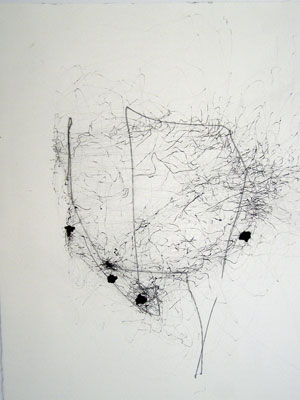
Fergus Byrne: Fractals, 2004, pencil on paper, 27 x 54 cm; courtesy the artist
The premise for Auto-mano at the Talbot Gallery lies in Joe Stanley and Fergus Byrne’s mutual interest in compositions resulting when standard methods of drawing are replaced by an inquiry into the broader potential for mark-making as a result of movement. The works on display, from series developed over a number of years, each represent finished works in themselves but also act as a record of activity, the accumulated layers of marks and lines over a determined period of time forming each final composition.

Joe Stanley: Auto-geo mechanism, 2002, mixed media, 18x15x15cm; courtesy the artist
First impressions of the drawings suggest lines drawn at random. However, upon entering the exhibition the viewer is immediately faced with Stanley’s ‘Auto-Geo’ mechanism, on display in an attractive wooden and glass case, a reminder that these works are in fact composed within certain parameters laid out by each artist; this ensures compositions emerging within a somewhat controlled framework to provide some consistency in output.

Joe Stanley: Auto-geo No.5, 2004, ink and graphite on fabriano paper, 56 x 38 cm; courtesy the artist
Stanley’s drawings result from separate journeys undertaken between three consistent co-ordinates around Dublin; a self-made Global Positioning System placed in the boot of the car, consisting of a wooden box holding the paper and a circular mechanism on casters holding the pen and pencil, is the method of choice for recording each journey. The casters allow the apparatus to roll freely, thus documenting the rise and fall of the road, each acceleration, deceleration, twist and turn; although the route is the same, the changing responses at the wheel of the car and external influences impacting on the journey ensure that no two drawings are the same. The concept behind Stanley’s drawings stem from an interest in cartography; however, somewhat similarly to Kathy Prendergast’s City drawings (begun 1992), cartographical traits are discarded in favour of focusing on quality of line to represent place and routes travelled. The result is that Stanley’s drawings vary in form, regardless of the parameters in place. While some works appear denser, with accumulated blots of ink at given points, others are less shaded where pencil line is less prominent; some lines twist while others bounce more sharply back and forth; what materialises is the element of indeterminacy which is common to the work of both artists.

Joe Stanley: Auto-geo No.8, 2004, ink and graphite on fabriano paper, 56 x 38 cm; courtesy the artist

Fergus Byrne, Anthony Kelly, David Stalling, Slavek Kwi, Sven Andersen: performance, ppening reception, Talbot Gallery, 25 March 2010; courtesy Talbot Gallery
Byrne’s drawings emerge as a response to the soundscapes created by members of the Soun.Din performance collective; to reduce the possibility, however, of resorting to a conscious fashioning of visual representations, Byrne creates these works ‘blind’ to uncover a new language, expressed non verbally using the body, and derived from ‘instinctive’ responses to the sounds created. Byrne’s parameters are the size of the page, the length of the sound piece to which he responds, and the selection of pencils prepared for use. The cited influence of dance and performance training become evident here, particularly ‘Body Weather’, where a keen training of the individual, physical senses and microscopic movement are important; the latter is reflected in the short, abrupt and narrow strokes almost consistently employed for the drawings. Artists such as William Anastasi and Lucio Pozzi have also experimented with blind drawing as an exercise in drawing with the body rather than the mind.

Fergus Byrne, Paradoxsingingtrainsforage, 2004, pencil on paper, 27 x 54 cm; courtesy the artist
A screen included in the exhibition allows us to relive a live performance from the opening night, when Byrne offered visitors an insight into his process, creating a drawing on the spot to a music piece by sound artists Slavek Kwi, David Stalling, Anthony Kelly and Sven Anderson. In reaction to a sound installation, composed using a variety of musical instruments and technological equipment, Byrne draws, eyes closed, as the music sways between steady reverberations and crescendos of sound. This videoed performance allows a greater understanding of his works: Byrne draws with his hands but allows the movements of his whole body to influence the compositions. It could be said that these pieces go beyond drawing to become an interaction between the page and the action of the body as a whole. Byrne’s aural perceptions of the unique soundscapes he is presented with, coupled with a changing selection of pencils, result in drawings varying in intensity, form, line and colour. Certain drawings also display words, some more intelligible than others; the implication is that Byrne’s natural response is by way of line but that words entering the physiological journey stimulated by the soundscapes can feature too.
Auto-mano, a playful reference to the two processes for creation, provides a platform from which discussions on drawing will undoubtedly emerge. Stanley’s self-built mechanism acts as a channel through which the compositions emerge ‘automatically’, the artist at the wheel indirectly influencing the creative process, while Byrne’s direct use of pencils in hand transfers physical, physiological and psychological responses to aural stimuli onto the page. A notable difference dictated by these different processes is Stanley’s unbroken, more sweeping lines in contrast to Byrne’s more abrupt marks, often reduced to hasty dots, permitted by the freedom to remove pencil from paper and begin a new line elsewhere on the page. While there are parameters in place, the seemingly random compositions emerge due to a relinquishing of full control during the creative process; in neither case will the visual impact on the outcome of the work.
Róisín Russell lives and works in Dublin.